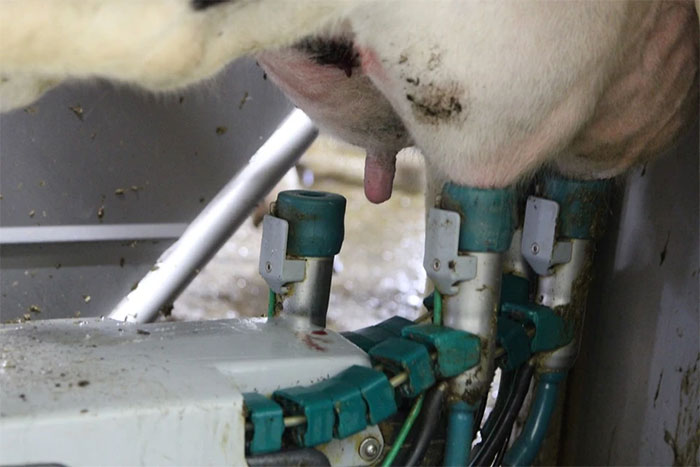New characteristic discovered that makes H5N1 bird flu virus easily transmitted to humans
New research from experts at the University of Pittsburgh School of Medicine and Emory University School of Infectious Diseases in the US shows that the avian influenza virus (H5N1 virus) in raw milk can survive on metal and rubber parts of commercial milking equipment for at least an hour, increasing the possibility of infection to humans and other animals.
The study highlights the increased risk of avian influenza exposure for dairy farm workers and suggests a need for more widespread use of personal protective equipment, including face shields, masks and eye protection.

Automatic cow milking equipment at Honbu Farm, Japan. (Photo: Dao Thanh Tung/TTXXVN).
'Dairy cows must be milked even when they are sick, and the length of time the virus in milking waste remains viable on equipment is unclear,' said study lead author Valerie Le Sage.
'The concern is that the virus can survive in raw milk for hours and has the potential to infect farm workers or spread from animal to animal.'
Clinical symptoms of avian influenza can range from mild fever and cough to difficulty breathing and pneumonia. The disease can be fatal.
Since March, when the bird flu virus was first detected in dairy cows in the United States, it has spread to other states and infected at least three people.
Although the current risk to the public remains low, according to the US Centers for Disease Control and Prevention, influenza viruses can quickly adapt to spread from person to person.
To understand the potential for transmission from cattle to dairy farm workers, researchers studied the stability of infectious influenza virus particles in raw milk droplets on metal and rubber components of commercial milking equipment.
In a laboratory environment that simulated the humidity and temperature of an outdoor milking barn in Texas, H5N1 virus particles suspended in milk remained stable on metal and rubber for more than an hour.
Meanwhile, H1N1 (swine flu) virus particles, which behave similarly to H5N1 in the laboratory, remained infectious for at least 3 hours on rubber and at least 1 hour on stainless steel.
"Our data suggest that milking equipment surfaces can remain contaminated for long periods of time, increasing the potential for transmission from sick animals to humans ," said Le Sage.
'These findings highlight the importance of face shields, masks and eye protection, as well as increased disinfection of equipment between cows to reduce risk to workers and reduce spread between animals,' he said .
- China records cases of H5N1 clade 2.3.4.4b
- H5N1 flu appears in poultry in Ninh Thuan
- Modified H5N1 virus can spread from pigs to humans
- Risk of infection with H5N1 bird flu from bird nest
- Indonesia discovered new strains of H5N1 influenza virus
- Ninh Thuan announced H5N1 outbreak in bird's nest
- Rounding out the announcement of the bird flu epidemic infected with H5N1
- H5N1 virus in England breeds 99.96% virus in Hungary
- Thousands of bird nest died positively to H5N1
- Restart studies of H5N1
- Red alert bird flu in Hong Kong
- H5N1 virus can be transmitted from mother to fetus
 March 2012: Launching H5N1 vaccine for poultry
March 2012: Launching H5N1 vaccine for poultry Experts comment on the mysterious gradual disappearance of the Delta variant in Japan
Experts comment on the mysterious gradual disappearance of the Delta variant in Japan Danger of the two Delta . branch variants
Danger of the two Delta . branch variants 2020 pandemic flu attack humans?
2020 pandemic flu attack humans?